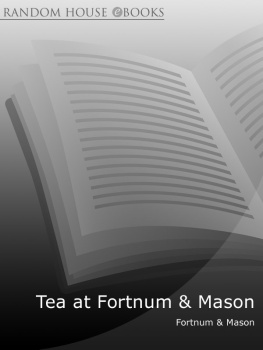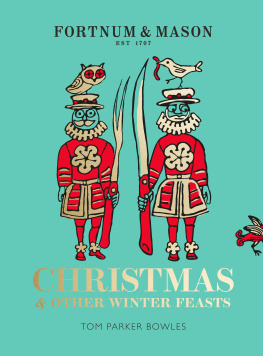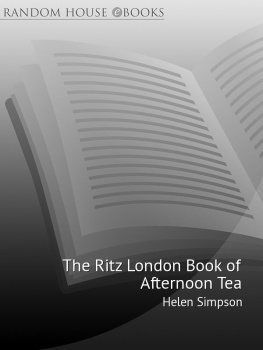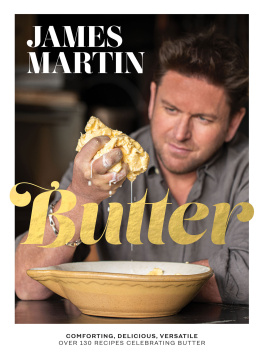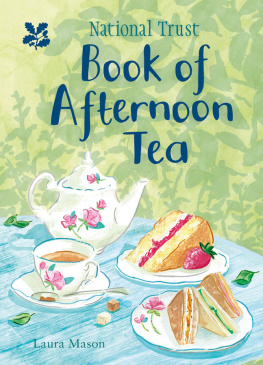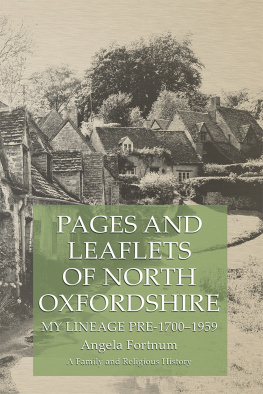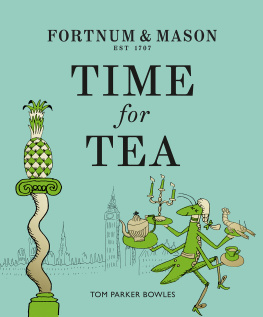Contents
List of Recipes
Introduction
The world of tea and the name of Fortnum & Mason have been intertwined for over three centuries. From the opening of the Far East to western trade, to the first harvest of tea grown on English soil, Fortnums has sourced, refined and offered this most delicious of the Earths bounties to its customers.
Each generation discovers tea anew, and develops its own preferences. Whether ancient Chinese blends, perfumed teas, or invigorating green or red bush tea, Fortnums has sourced the best examples of their kinds.
To celebrate this long and fruitful relationship, I am delighted to introduce this tribute to tea and its place in society. Delicious recipes are complemented by the fascinating history of tea, the properties of individual teas and that most traditional of English pastimes taking tea. If you love tea, I recommend this short compendium for your delight.
Kate Hobhouse
Chairman
The History of Tea
THE ORIGINS OF TEA
Tea originated in China but myth and mystery surround the actual discovery of what was to become Fortnums finest and most famous offering. One story relates how, in 2737 BC , the learned Emperor Shen Nung was gathering plants. He rested under a tall wild tea bush and boiled some water for refreshment. A few leaves lazily drifted down from the branches and fell into the water. The resulting stimulating and refreshing liquor is what we now call tea. A later legend describes how Dharuma, a Buddhist monk, fell asleep while meditating. He punished himself for this transgression by cutting off his eyelids. They fell to the ground and there the first tea bushes grew. Wild bushes may have been the Emperors choice as a source of tea, but the plant has been cultivated for millennia. Connoisseurs during the Tang dynasty (618906 AD ) crushed steamed bound-together leaves to make a sort of tea powder that was then mixed with a variety of flavourings including plum juice and onions, the latter being arguably an acquired taste.

Fortnum & Masons tea selection in 1927

Christmas Catalogue, 1931
Sung Dynasty (9601279 AD ) tea drinkers whipped ground tea into hot water until it was frothy, which sounds rather like a very early tea cappuccino. There is no record of onions being added to this concoction, but flowers and essential oils made sure it was extremely exotic. It was not until the Middle Ages that tea drinkers in China (13681644 AD to be exact) developed tea as we know it today. Steamed leaves were dried, added loose to the water and left to steep, before being poured into white porcelain to display its colour. Drying the leaves allowed the tea to ferment or oxidise to a coppery red, and made it easier to store while preserving its essential characteristics. It also meant that it was fit to travel to far-off lands.
Although tea drinking has become inextricably linked with Englishness, it was in fact introduced to Europe by Portuguese and Dutch traders in the early seventeenth century. Tea had reached London by 1658, although it took the marriage of Charles II to Catherine of Braganza (a Portuguese princess) to make it wildly fashionable at court. The court connection was important in the creation of a certain tea emporium in the heart of St Jamess

Dr Johnson and Mrs Thrale over tea and cakes
FORTNUM & MASON A RELATIONSHIP WITH TEA
In 1707, livery stables owner Hugh Mason and royal footman William Fortnum set up business together as Fortnum & Mason, grocers and tea merchants. Tea was the commodity on which the two young men built their dreams and grew their business. William Fortnum had family connections that entailed an intimate association with the magical brew; one of his cousins worked for the East India Company, the principal means of import of what was to become the national drink.
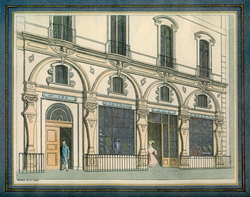
Fortnums faade, 1840
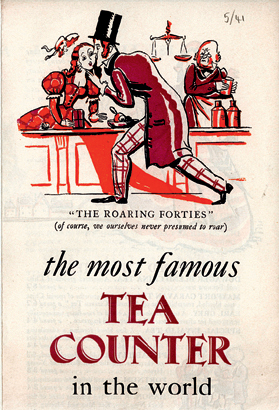
A special tea flyer, 1930
AN ENGLISH BEVERAGE OF CHOICE
It took between twelve and fifteen months for precious shipments of tea to travel to Britain by sea. The costs of bringing the tea from halfway across the globe, and heavy taxation, meant that initially only the wealthy enjoyed it in its unadulterated form. By 1707 tea smuggled from Holland was booming on the black market, and much of it was padded out with unmentionable substances. Discerning and law-abiding tea drinkers flocked to Fortnum & Mason to buy pure (and purely legal) tea, including strong black teas, that had been created especially to withstand the long journey westwards.

Page taken from a Tea Commentary, 1924
The eighteenth century saw the amount of tea drunk in England grow by a staggering 225 per cent, and Fortnum & Mason can lay claim to some small contribution to the rise in its popularity. In 1784, the government gave in to the inevitable and decided to battle the smugglers by reducing tax on tea from 119 per cent to just 12 per cent. Now nearly everyone could drink tea legally. It soon became a popular breakfast drink, replacing ale and gin, and gradually it became the drink to enjoy at any time of the day.
The same century saw coffee houses fall out of favour, to be replaced by elegant open-air tea gardens, which enjoyed the patronage of the most fashionable in society. Perhaps the most famous were Ranelagh Gardens in Chelsea, which opened in 1742, its principal feature being a rotunda designed on the Pantheon in Rome. Entry to the gardens cost two shillings and six pence (around 12p), which of course included tea! One of its most famous visitors was Mozart, who played there for the Duke of Cumberland.
THE BOSTON TEA PARTY
Tea drinking took off in America at the end of the seventeenth century and the fashion for tea gardens became popular there, too. In Boston, a major seaport, tea symbolised wealth and social status. America was a British colony at that time, and much of its tea was imported from Britain, including a good share of it from Fortnum & Mason.
In 1767, Parliament increased taxes on tea and other goods in the American colonies to cover administrative costs in the New World. It proved immensely unpopular, and while over the ensuing years taxes on some goods were lifted, the hated tax on tea remained. One fateful day in 1773, seven ships from England arrived carrying tea. Bostonians, many dressed as Native Americans, boarded one of these, the

